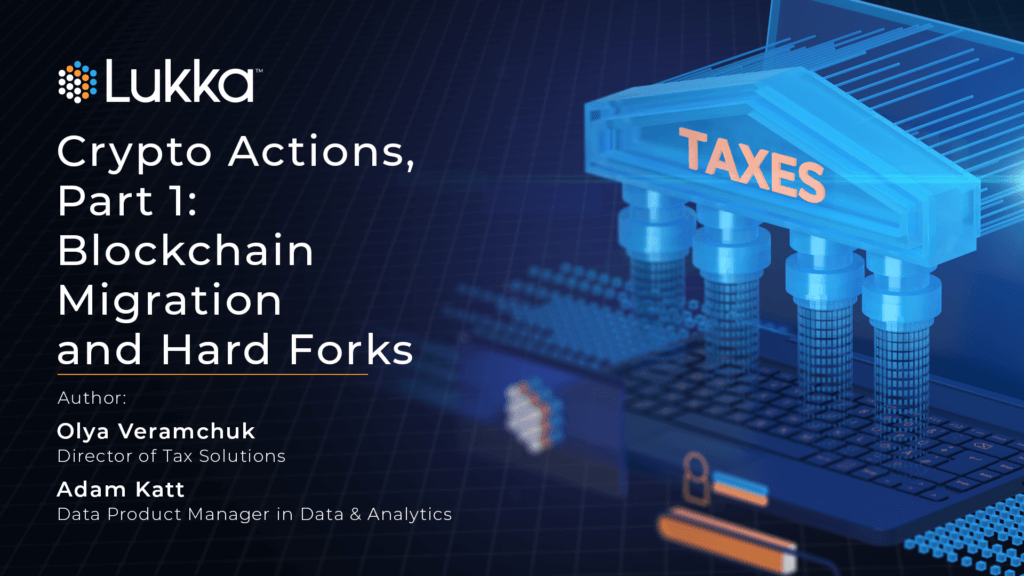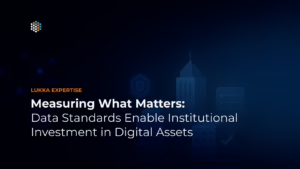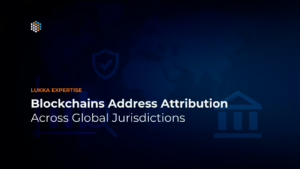Author: Adam Katt and Olya Veramchuk
The term “corporate actions” is well known in traditional finance as an event by a public company that may affect the company’s securities and, consequently, its shareholders and bondholders. Examples include making a change to a company’s name, issuing a dividend, or even restructuring through a merger or bankruptcy. These transactions are familiar, have an established framework, and can be categorized and analyzed for different purposes, including taxation.
However, the crypto ecosystem has introduced completely novel event structures to this framework that are highly focused on decentralized technology itself and can occur faster or more unpredictably. It is difficult to fathom a publicly-traded company splintering off into over 100 distinct entities with competing goals, but we know in the digital world, Bitcoin birthed more than 100 hard-forked assets in the 2010s. The dynamic and unprecedented ways in which digital assets can change and transform have brought a huge challenge to market participants: how does one categorize, analyze and prioritize events like hard and soft forks, migrations, airdrops, burns… and the list goes on.
In addition, without a source of standardization, events as simple as ticker symbol changes may potentially create certain reporting issues for users. The lack of consistency in how changes are tracked can lead to materially inaccurate tax lot matching, where such lots are created across entities using different ticker symbols to represent the same asset or, alternatively, the same ticker symbol is utilized to represent different assets. This can make something as simple as applying a lot relief methodology challenging or not possible without first applying reference mapping data. Bitcoin fork history illustrates the nearly impossible task of tracking newly formed assets and their respective naming conventions.
Just as in traditional finance, some “crypto action” events (as we call them at Lukka) are more impactful than others. When looking specifically at assets – rather than entities in the crypto ecosystem – crypto actions can broadly be categorized as either a complete change to an asset’s structure or as a change to its characteristics. Understanding the type and degree of change is important in facilitating analysis of the relevant tax, accounting, and legal implications. Here is a look at some crypto actions and the tax consequences they prompt.
Asset and Blockchain Migrations
Overview
Migrations are a constant occurrence in the digital asset space and can have a variety of effects on the structure of an asset. Assets can migrate from contract to contract on the same protocol and also from one blockchain platform to another, or both. Migrations can occur for multiple reasons, including bringing new assets into an existing product ecosystem, expanding support to new protocols, upgrading asset functionality, or movement of an asset from testing environments to production.
An example that encompasses several of these scenarios is the migration that Project Hydro initiated last year. In this case, the project was looking to expand its reach and avoid high Ethereum gas fees by migrating HYDRO, its native token, to the BNB Chain. They also intended to respond to community feedback that the total supply was too large by reducing the supply and adding burn functionality to the asset smart contract. This was accomplished in two phases:
- Old HYDRO ERC20 tokens in personal wallets were migrated directly for new HYDRO BEP20 tokens at a 100:1 ratio (a migration between two blockchains).
- The remaining old ERC20 HYDRO tokens were swapped for new ERC20 HYDRO tokens at a 100:1 ratio on a per exchange basis (a migration between two contracts on Ethereum).
As a result, there were two new versions of the HYDRO asset on different blockchains, and users who had previously held 100 old tokens now only held 1. The Hydro Project stated that the old HYDRO tokens were now obsolete.
What this means from a tax perspective
Generally, under the US tax principles, a realization event would occur when two conditions are met: there is a sale or exchange of assets, and the asset received is materially different in kind or extent from the asset given up1. Every instance should be reviewed on a standalone basis to determine whether there is a taxable event or not because the difference in the fact pattern may result in different tax treatments.
Consider moving an asset from the testing environment to production. It is unlikely that any assets are exchanged or there are any new features added. Consequently, it probably shouldn’t be treated as a taxable transaction. Similarly, enhancing existing assets with some new capabilities or improvements but not exchanging the original token iterations for the new and improved ones should not give rise to tax.
However, an asset swap with a migration to a new blockchain would likely yield a different result. The HYDRO migration example outlined above clearly shows that the original tokens were exchanged for the new tokens at the 100:1 ratio. Further, because the new tokens had new capabilities as compared to the original tokens, it is reasonable to suggest that they were materially different from the original tokens. Thus, both realization requirements were met, resulting in a taxable exchange for the token holders.
There are many other examples that are much grayer than the ones discussed. For instance, certain exchanges offer swapping ERC-20 versions of digital assets for the native ecosystem tokens (consider KuCoin facilitating the KAI swap). Note that this is slightly different from the so-called backdoor bridging offered by some centralized exchanges. There, the investors could deposit or buy tokens on one blockchain but withdraw them on a different blockchain. The key differentiator between a migration and a backdoor bridge is that a migration is an infrastructural change and not a permanent pathway designed to facilitate financial trading.
The views on taxation of such ERC-20/native tokens swap vary. Some tax practitioners believe it is unreasonable to treat such swaps as taxable trades because the investor retains the benefits and burdens of owning the asset, and thus there is no exchange for tax purposes. We have discussed this issue in detail in our earlier blog.
Other tax experts take a more literal view of the transaction and consider it an asset-for-asset exchange. Further, they look to the like-kind exchange guidance issued by the IRS last summer2, where the IRS maintained that every blockchain was “fundamentally different from each other.” Consequently, if an asset migrates from one blockchain to another, then it would likely gain new capabilities and therefore be materially different, resulting in a taxable transaction. There is no formal guidance on the matter. Thus, taxpayers are encouraged to discuss any points of contention with their tax advisors.
Hard Forks
Overview
Hard forks are arguably the most (in)famous events in the blockchain ecosystem. There are many ways in which hard forks can be implemented. They generally involve a change to a single blockchain protocol that makes previous versions incompatible with that protocol going forward. Whether this revision is to implement new features or create an entirely new asset based on an old one, this new branch or “fork” of the blockchain protocol stems from the previous one.
Although it is often the case, both branches do not need to be “adopted” for an event to qualify as a hard fork. While many hard forks are the result of divergent views on protocol management in which the community must choose which branch to support, many are part of planned upgrades in a blockchain’s development.
Two very different examples of forking are the London hard fork on Ethereum and the Bitcoin Cash fork from Bitcoin.
In the case of the London fork, Ethereum was implementing a network functionality upgrade that resulted in a new set of rules for transaction validators going forward. While a new branch of the protocol was created from a technical point of view, the old branch was deprecated, and only one Ethereum persisted in the market.
The Bitcoin Cash fork from Bitcoin resulted from a disagreement between market participants on how the protocol should operate, thus giving birth to two completely separate assets. In 2017, holders of Bitcoin were credited with Bitcoin Cash when the fork occurred. Users of these crypto assets should consider these differences when analyzing their tax implications.
What this means from a tax perspective
Unlike many other issues in the digital asset space, tax treatment of hard forks was addressed by the IRS in the Revenue Ruling 2019-24, with some subsequent clarifications in the ILM 202114020 and FAQs on Virtual Currency Transactions.
The IRS defines a hard fork as an event that “occurs when a cryptocurrency on a distributed ledger undergoes a protocol change resulting in a permanent diversion from the legacy or existing distributed ledger” and which “may result in the creation of a new cryptocurrency on a new distributed ledger in addition to the legacy cryptocurrency on the legacy distributed ledger3.”
Consequently, it is important to distinguish between the events resulting in an airdrop of a new digital currency and those that do not.
Generally, when a hard fork is not followed by an airdrop of a new cryptocurrency, no taxable income should be recognized, and no reporting is needed. The Ethereum London hard fork discussed above is a great example of a non-contentious hard fork.
In contrast, contentious hard forks followed by an airdrop of the new cryptocurrency result in ordinary income recognition under the current guidance. The assets received should be reported at the fair market value, provided the recipients have dominion and control over such assets, i.e., can, exchange or otherwise transfer them. This is illustrated by the Bitcoin Cash hard fork discussed above.
To summarize, tax consequences and reporting requirements can vary quite significantly depending on the blockchain event. Therefore, taxpayers should always do the due diligence to understand what, if any, implications would apply.
Treas. Reg. Sec. 1.1001-1(a)
CCA 202124008
Revene Ruling 2019-24
About Lukka
Lukka is a firm that helps solve some of the greatest financial challenges in crypto and has the intellectual resources, along with the data and processing capabilities, to test hypothetical scenarios like the one here. For more information on how Lukka puts data to work across multiple finance sectors, traditional and decentralized, supporting industries from insurance to Formula E, go to our website at Lukka.tech



